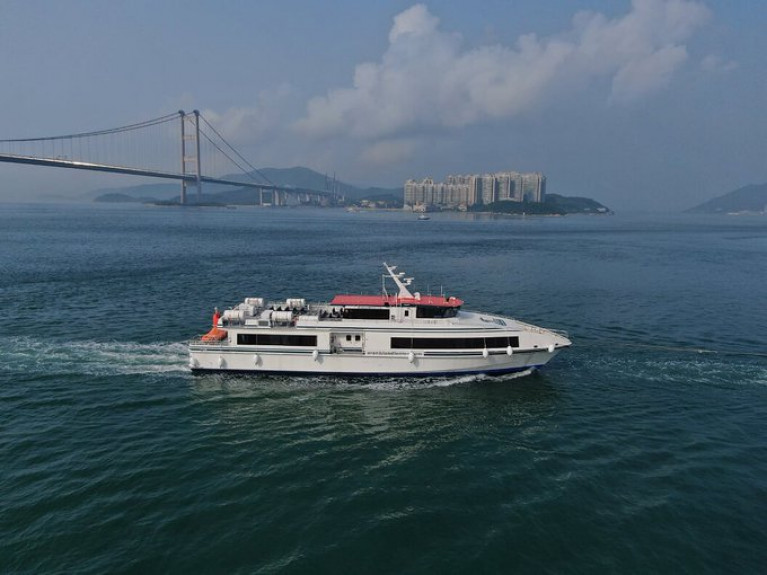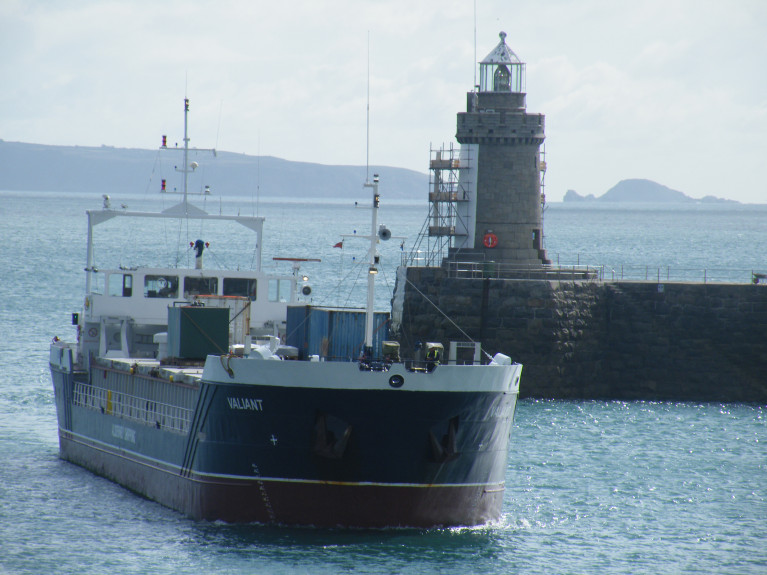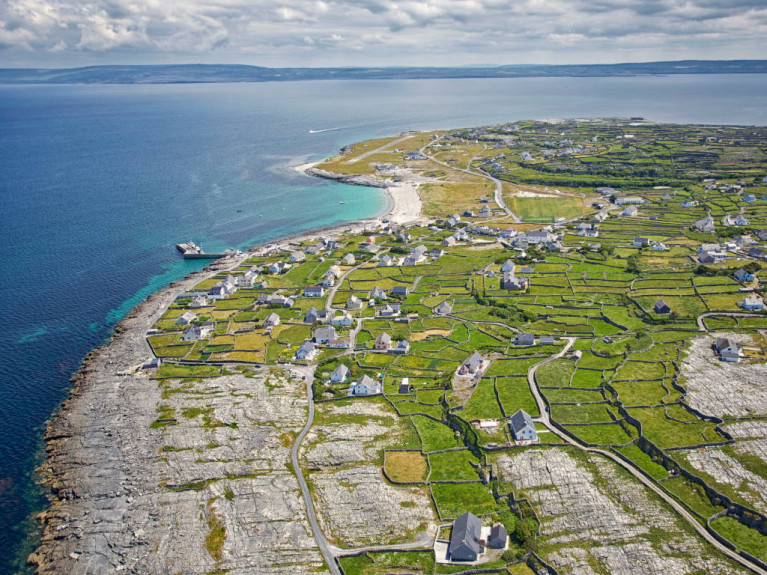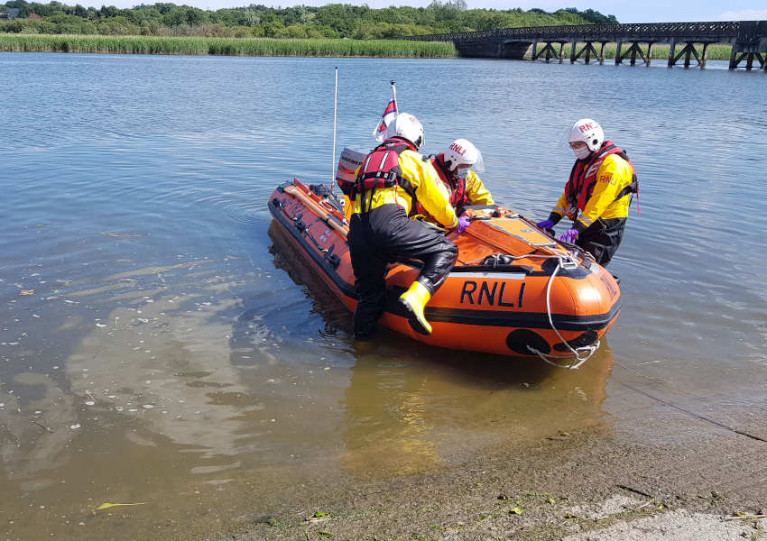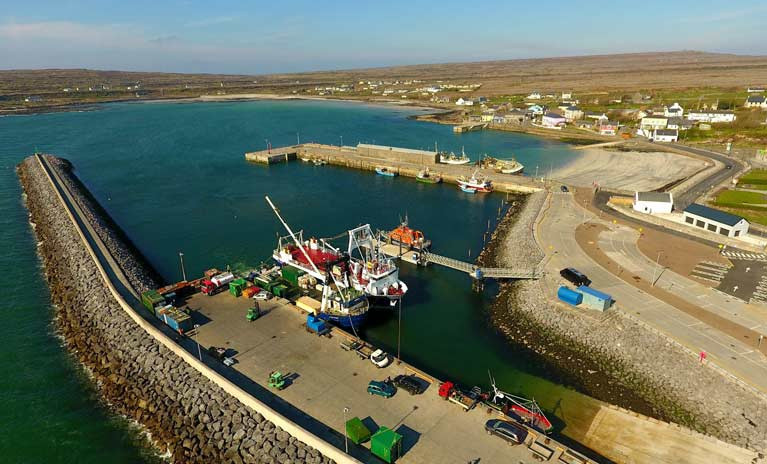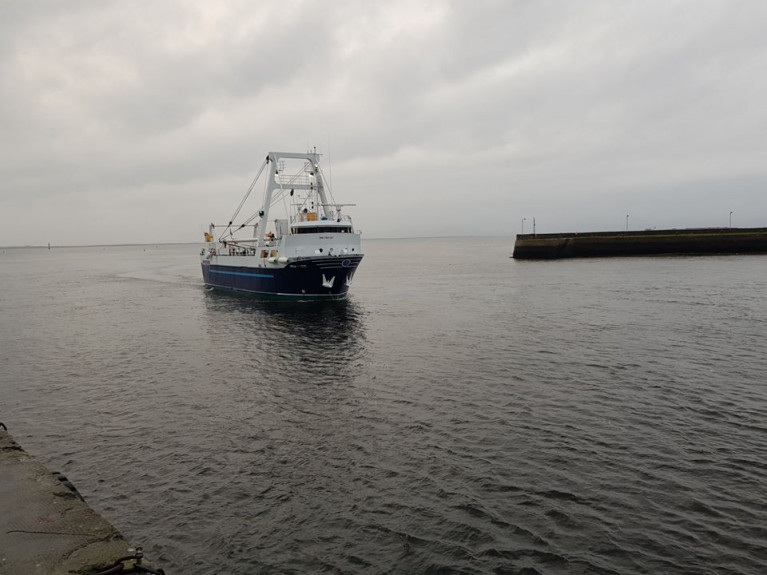Displaying items by tag: Aran Islands
Aran Islands Ferry to Become Ireland's Largest Domestic Passenger Ferry to Enter Service 2021
A new ferry will be Ireland's largest domestic passenger ferry when the 40-metre 'Saoirse na Farraige' arrives in Galway Bay this October.
As Independent.ie writes the ferry constructed in Hong Kong with a capacity of 400, is expected to enter service next April with Aran Island Ferries.
It will operate from Rossaveel, Co Galway to all three Aran Islands, taking 45-minutes to reach Inis Mór, 50 minutes to Inis Meáin and 55 minutes to Inis Oírr, the company says.
'Saoirse na Farraige' is the sixth ship for a company owned by the O'Brien family of Connemara, who first began carrying passengers to the Aran Islands on a Galway Hooker, under sail, decades ago.
"We know it’s an extremely difficult time for businesses in many sectors (ours included), but we hope this will brighten up Galwegians’ spirits and that when we travel again, the ferry will have a positive impact on tourism in the west of Ireland," said Sales and Marketing Manager, Áine McLoughlin.
For furthermore on this newbuild ferry click here.
Minister of State Hildegarde Naughton has praised the coastguard, Garda and local volunteers for their quick response in the rescue of two missing paddle boarders in Galway Bay today, Thursday 13 August.
As reported earlier on Afloat.ie, the two young women were found clinging to a lobster pot marker off Inis Oírr in the Aran Islands after a major overnight search and rescue operation.
Naughton, the Fine Gael TD for Galway West, said: “I would like to offer my sincere gratitude and thanks to all members of the Irish Coast Guard, An Garda Síochána and local volunteers who worked tirelessly overnight and this morning in the search for the two missing paddle boarders since the alarm was raised last night.
“Their quick thinking and bravery have resulted in the safe return of two young ladies to their families today.
“The appreciation of the work of our emergency services can be heard in the shared sigh of relief not just across Galway, but indeed nationwide, as the good news reached us this afternoon.
“Thankfully this most recent event has had a happy ending; however, it is imperative for us all to be vigilant of the sea and the elements as we enjoy our coastline during the fine weather.
“Just last month I launched the newly updated Safety on the Water website in collaboration between the coastguard, RNLI, Water Safety Ireland, Irish Sailing and BIM. I would invite everyone to familiarise themselves with the guidance that has been provided by those who know our waters the best by visiting www.safetyonthewater.gov.ie”
Sisterships of Previous & Current Operator At Irish Ports Either Side of the Midlands
Ships come and go and at times sisters can be in Irish Port waters at the same time albeit apart and also serving different owners as in an example of today, writes Jehan Ashmore.
The ship's been the Alsterdiep (2008/2,954grt) which is currently at anchorage in Dublin Bay on the eastern seaboard. Whereas the newer 2009 built but slightly smaller sister, Vitality of 2,984 gross tonnage is located on the opposite west coast while docked in the Port of Galway. (See: related story of Norwegian flagged ship averted from disaster).
Alsterdiep is operated as part of the Hartmann Group with global offices among them a headoffice located in Leer, Germany. The vessel had sailed from Shoreham, an English Channel port and is awaiting in the bay to enter Dublin Port this evening to Alexandra Basin.
The Vitality formerly the Allerdiep, a similar name of the Alsterdiep as suggests had served the same German shipping group until almost a decade ago when renamed in September, 2010.
Both the ports in Dublin and Galway are almost virtually on the same latitude and just short of 220kms in distance apart based on a route taken on the M6 motorway.
This main national road connecting the capital and the 'City of the Tribes' is from where the coastal cargoship Saoirse Na Mara was also in port. Albeit this former Norwegian flagged vessel uses the Outer Pier exclusively serving the Aran Islands trade of a Government awarded contract to Lasta Mara Teoranta to provide the cargo service.
As for Vitality is operated from waters closer to home compared in the case of Alsterdeip, as the former ship is controlled in the neighbouring UK. This is where Faversham Ships Ltd (coastal town in Kent) operate a fleet. The shipowner is actually based in East Cowes, Isle of Wight with an associate company based in the Netherlands.
Vitality had sailed from Liverpool 'light' (without cargo) to the Irish mid-west port as Afloat confirmed with the City of Galway Shipping Agency, which was established almost a century ago in 1921. The cargoship had been loading limestone and as scheduled departed this evening and is bound for Ayr in south-west Scotland.
Ahead in Galway Bay was the aforementioned Saoirse na Mara (1980/597grt) which this evening is bound for Inishmaan, located between the other two Aran Islands.
A fleetmate of Vatality the smaller Valiant (1993/1,512grt), Afloat spotted back a few years ago while operating on the English Channel as an inter Channel Island routine ship operating on behalf of Channel Seaways, part of Alderney Shipping.
The Poole-Channel Islands operator competes with Channel Island Lines based out of Southampton where the Irish flagged short-sea trader Huelin Dispatch of Dundalk Shipping was chartered but this has ceased. Earlier this year the ship however returned to Irish waters to receive a routine dry-docking in Rushbrooke, Cork Harbour.
Afloat today tracked Huelin Dispatch (2012/2,597grt) in UK waters having departed Tees and is bound for Hull also on the North Sea and beforehand of recent months Norway among Scandinavian waters. The short-sea drycargo ship was built by the Dutch Damen shipyard group and to their own Combi Coaster 3850 design which has proven popular for ship-charterers. The design has also favoured Faversham Ships with a quartet in service following the introduction in 2018 of the Ventura which joined the Vedette, Beaumont and Musketie.
Another cargoship docked in Galway and opposite of Vitality in the lead in channel to Dun Aengus Dock proper is Wilson Calais (2001/2,994grt) which has been to Galway before and on one occasion to discharge wind-turbine blades. The current call of the Norwegian ship's operator, Wilson Management of Bergen saw them deploy the vessel make a short coastal passage around Co. Clare from Limerick Docks, a voyage duration taking almost 12 hours.
Scrap metal was loaded onto the Wilson ship which acquired a pair of Arklow Shipping 'R' class dry-cargoships this year.
Afloat will have more to report on the relationships of such shipping links as highighted to showcase the shipping scene in domestic waters, the Irish Sea and neighbouring waters of the UK and those of the Channel Islands.
Gales Cushion Impact of Island Reopening to Visitors - Sean Kyne Plays Down Impact of Social Media Post
Gales over the weekend have cushioned the impact of full re-opening of offshore islands to visitors as COVID-19-related restrictions are eased.
However, there has been a steady increase in traffic to the Aran islands, served currently by one ferry from Ros-a-Mhíl in Galway to all three islands.
Ros-a-Mhíl company Island Ferries requires passengers to wear masks. However, Comhar Caomhán Teo, the Inis Oírr co-op, has asked the Government to sanction resumption of the subsidised ferry to Inis Meáin and Inis Oírr as this would allow for greater social distancing.
Former Gaeltacht and Island minister Sean Kyne - now a senator - had argued for a phased re-opening of all islands on public health grounds, stating he had received compelling medical advice from island doctors.
He had opposed the advice from the National Public Health Emergency Team (Nphet) which had cleared visits to offshore islands from all parts of Ireland from June 29th.
Several days before the announcement, Inis Oírr said that 92 per cent of its residents and businesses oppose re-opening for the remainder of the summer due to fears over the spread of Covid-19.
There has been one confirmed case of Covid-19 to date on the largest island of Inis Mór, with a population of 800 people. All three Aran islands have had water rationing over the last couple of months, with night-time restrictions on two islands only eased last week.
Two Co Clare-based ferry companies offering seasonal day trips to the Aran islands and Cliffs of Moher did not sail to the two smaller islands last week due to the residents’ concerns.
Mr Bill O’Brien of Doolin Ferry Company, which has three vessels with capacity for almost 600 passengers in total, said he had received an email from the Inis Oírr co-op after its vote, asking his company to respect the wishes of the islanders.
“We said we’d do that, but we are hoping in a week or two that this might change,” Mr O’Brien said.
Doolin 2 Aran Ferries marketing manager Joan Hamilton said that it was also “respecting the wishes of the people of Inis Oírr” and had decided not to sail to Inis Meáin also as it had limited facilities and “it would not be fair to them”.
Inis Meáin businessman and owner of the internationally successful knitwear company Tarlach de Blacam said he believed the debate over the pressures of tourism on the islands was “now taking place”.
“People including my son [Ruairí de Blacam of the Inis Meáin Restaurant] have invested in quality accommodation on the three islands and that brings in more revenue than day-trippers,” he said. “This debate about sustainable tourism is taking place now all over Europe.”
Inis Mór wedding celebrant Dara Molloy said that effectively there had been a phased re-opening last week, as only one Island Ferries boat was sailing from Ros-a-Mhíl for all three islands and there had been “no big crowds”.
Meanwhile, as The Sunday Times reports today, Aran island residents have expressed anger and disappointment over a social media post – uploaded during a divisive debate over re-opening to visitors without adequate supports - which depicted them as one of the earliest primates in the human evolutionary tree.
The graphic, which has since been removed, compared “the people of Aran” to Australopithecus robustus, an extinct species dating to between 1.5 million and 2 million years old and first identified from fossil remains in South Africa.
Over a caption reading “Minister Sean Kyne says ‘Islanders are nervous about reopening after not seeing any tourists for a long number of months’,” the graphic showed five evolving primates with one arrow for “The people of Aran” pointing to the hunched Australopithecus and another for “People on the Mainland” pointing to upright Homo sapiens.
In the second graphic, a cartoon image of Mr Kyne depicted him as “Minister for Primitive People”.
Mr Kyne said he had been sent the links but had taken no action as he believed the debate had been very heated and such criticism was “part of the cut and thrust of politics”.
Comdháil Oileáin na hÉireann/Irish Island Network secretary Rhoda Twombly said she understood the social media graphics posted by Inis Mór’s Óstan Arann owner Keith Madigan had been removed after criticism.
She said she would “deplore anything that denigrates any of the island population”.
Mr Madigan did not respond to requests for comment.
Read more on The Sunday Times report here
"Fear of Law Suits" May Have Influenced Government Decision to Approve Early Reopening of Islands
Outgoing Gaeltacht minister Sean Kyne has expressed disappointment at the Government decision to approve early re-opening of offshore islands to visitors from Monday (June 29).
The Attorney General had advised the Cabinet that there could be legal consequences if it did not abide by the advice of the National Public Health Emergency Team (NPHET), Mr Kyne confirmed.
Offshore communities had been taken by surprise when NPHET announced a week ago that travel to and from islands could resume from June 29th.
The Government’s “road map” had originally set from August 10th as a date for all but essential travel to and from islands.
Mr Kyne said he contacted Taoiseach Leo Varadkar and Cabinet colleagues about the need for a more phased approach, given the lack of time to prepare for anticipated large numbers of domestic visitors.
Mr Kyne confirmed that he had received appeals from Aran island medical professionals urging caution, but had also been contacted by tourism interests seeing an early reopening.
He said that NPHET’s advice to Cabinet was that there was no reason on public health grounds for curtailing visitors to the islands.
“I am disappointed - I expect some businesses will decide against reopening on Monday,” Mr Kyne said.
Two Aran islands – Inis Oírr and Inis Mór – held surveys which voted overwhelmingly against an early reopening.
All three Aran islands are in a declared Irish Water “drought” category, and have had water rationing due to the severe dry spell.
In Inis Oírr’s case, 92 per cent of residents and businesses voted against re-opening for the remainder of the summer due to fears over the spread of Covid-19.
A number of other islands have limited health facilities, lack of provision for public toilets, and limited scope for social distancing on piers during busy ferry berthing periods.
"The Government seemed to be more afraid about protecting itself against law suits by businesses than our public health," one island resident said.
Earlier this week, the Irish Islands Federation, Comhdháil Oileáin na hEireann called on the Government and NPHET to provide “clear guidance and protocols” on the safe re-opening of islands to visitors.
The federation pointed out it had not received any written reply to submissions to State agencies, "seeking direction and supports for the offshore islands".
Government Covid 19 data suggests that up to six electoral districts with islands had less than five cases of the virus, but the Department of Health would not comment further.
Island representatives are only aware of one case on the largest Aran island of Inis Mór and a very small number on Achill island, Co Mayo, which is connected to the mainland by a bridge.
The island federation had no comment to make yesterday.
Island Federation Calls on Government & Health Officials to Explain Safe Re-opening After Covid
The Irish Islands Federation has called on the Government to provide “clear guidance and protocols” on the safe re-opening of islands to visitors.
The federation, Comhdháil Oileáin na hÉireann, has also called on the National Public Health Emergency Team (NPHET) to provide more detail, amid considerable concern about its decision to approve early re-opening from next Monday, as Afloat reported earlier.
In a statement today, the island federation said it had not received any written reply to submissions to State agencies, "seeking direction and supports for the offshore islands".
“The board of Comhdháil Oileáin na hÉireann, on behalf of all offshore islands is again urgently seeking clarity and guidance from the Government regarding the safe reopening and required supports,” it said.
The NPHET decision to allow travel to and from islands to resume from June 29th, announced last Friday, threw offshore communities into confusion over the weekend.
Acting Gaeltacht minister Sean Kyne says he opposes the move and believes there should be a phased approach. He says this will be considered at this Thursday’s Cabinet meeting.
The Aran Islands, which had one confirmed case of Covid-19, has been on rationed water, and this is adding to residents’ worries if visitors are permitted.
There are also medical concerns about the elderly population’s exposure to the pandemic.
Mr Kyne said that apart from the water issue, local authorities had no time to prepare piers and public facilities and signage for an opening on June 29th.
While there has been a welcome from tourism interests, medical professionals have advised against an early opening, he said.
A survey conducted by the co-op on the Aran island of Inis Óirr last week indicated that 92 per cent of residents and businesses oppose re-opening for the remainder of the summer due to fears over the spread of Covid-19.
Islands had originally been closed until the beginning of phase five of the Government’s Covid-19 road map and expected to open again to visitors from August 10th.
Mr Kyne said that when phase five was scrapped, he received a large number of communications from island residents and businesses, expressing opposing views about the timing of re-opening.
“I’ve sent recommendations to the Taoiseach, who has been engaging with NPHET on this issue,” Mr Kyne said.
“Unless the islands can come up with an agreed position, however, the NPHET decision is the default one,” he said.
At a special sitting of the Dail Covid-19 committee late last week, Galway West TD Eamon Ó Cuiv (FF) proposed a special package of assistance to island businesses if there is later re-opening.
Gaeltacht Minister Sean Kyne says he opposes the National Public Health Emergency Team’s (NPHET) decision on an early lifting of travel restrictions to and from offshore islands.
The decision to allow travel to and from offshore islands to resume from June 29th, announced on Friday night, has thrown island communities into confusion.
There has been one case of Covid-19 on the Aran Islands, but the three islands are on water rations due to the long dry spell. There are also concerns about its elderly population’s exposure to the pandemic.
Mr Kyne said that apart from the water issue, local authorities had no time to prepare piers and public facilities and signage for an opening on June 29th.
While there has been a welcome from tourism interests, there are serious concerns among medical professionals and residents on a number of islands, he said.
A survey conducted by the co-op on the Aran island of Inis Óirr last week indicated that 92 per cent of residents and businesses oppose re-opening for the remainder of the summer due to fears over the spread of Covid-19.
Comdháil Oileáin na hÉireann is due to hold a board meeting this morning about the issue in a bid to secure a consensus in advance of next Thursday’s Cabinet meeting.
Islands had been closed until the beginning of phase five of the Government’s Covid-19 road map and expected to open again to visitors from August 10th.
Mr Kyne said that when phase five was scrapped, he received a large number of communications from island residents and businesses with opposing views about the timing of re-opening.
“I’ve sent recommendations to the Taoiseach, who has been engaging with the National Public Health Emergency Team on this issue,” Mr Kyne said.
“Unless the islands can come up with an agreed position, however, the NPHET decision is the default one,” he said.
At a special sitting of the Dail Covid-19 committee late last week, Galway West TD Eamon Ó Cuiv (FF) proposed a special package of assistance to island businesses if there is later re-opening.
Wexford Lifeboat Rescues Five From Sinking Jet Ski
Wexford RNLI came to the rescue of five people on Monday afternoon (15 June) after the jet ski they were on lost power and began to sink.
The four teenagers and an adult had managed to get on top of a nearby pontoon on the River Slaney between Ferrycarrig Bridge and Killurin Bridge, where they then raised the alarm with the Irish Coast Guard.
Wexford RNLI volunteers were paged just before 3pm and launched the inshore lifeboat with three crew on board within 12 minutes.
Once on scene before 3.30pm, the crew took the four teenagers on board the lifeboat and brought them safely ashore at Killurin.
The lifeboat then returned to the scene for the adult and jet ski. Conditions at the time were good with no swell and a falling tide.
Speaking following the callout, Wexford RNLI helm Damien Foley said: “Everyone was wearing lifejackets and did the right thing by calling for help to the coastguard when they could.”
The volunteer crew of Damien Foley, Ger Doran and David Marskell, all of who were working at the time, were back at Wexford Lifeboat Station at 4.30pm. It was also the first rescue for volunteer crew member David Marskell.
Elsewhere on Monday, Aran Islands RNLI responded to two medevac shouts, on Inis Oírr and Inis Mór respectively, bringing two women to the mainland for treatment — one for a suspected broken arm.
Aran Islands lifeboat coxswain Declan Brannigan said: “Our volunteers didn't hesitate to answer both calls today and we would like to wish both women a speedy recovery.”
The Aran islanders may have a ban on visitors, but they are already critically short of drinking water.
Irish Water and Galway County Council have introduced restrictions on water use lasting 17 hours a day on both the largest island of Inis Mór and the southernmost island, Inis Oírr.
Prolonged dry weather resulted in the first set of restrictions on April 20th, when supplies on the two islands were curtailed from 9.30 pm to 8 am daily.
The extension from 5 pm to 10 am daily is necessary to “ensure continuous daily water supply is available for residents and businesses on both islands for hygiene and other essential purposes during this continued dry spell”, Irish Water spokesman Tim O’Connor said.
Inis Oírr has suffered from long-running shortage issues, with supplementary water having to be shipped out in recent years. The three islands have had a dramatic fall-off in demand for water, since voting to shut down all tourism, including summer Irish colleges, in mid-March.
“Had we the normal level of visitors, we would be in a very serious situation now,” one Inis Mór resident noted.
“We are asking customers on both islands to be mindful of how they use water and thank them for their continuous conservation efforts to date. We would
Irish Water said it was “working at this time, with our local authority partners, contractors and others to safeguard the health and well-being of staff and the public and to ensure the continuity of drinking water and wastewater services”.
Inisheer off Co. Galway, at this time of year is normally a hive of activity with bands of tourists alighting from the ferries ready to soak up the peace and quiet. Or they may be arriving for Irish language or art courses or even to swim alongside Dusty the dolphin, whose presence has been absent from the waters for the last few months.
Inisheer, or Inis Oírr, is the smallest and most southerly of the Aran Islands and along with Inishmore and Inishmaan form a northwest-to-southeast barrier of sorts to Galway Bay. The tourist ferries from Rossaveal and Doolin, Co Clare, have ceased operations since mid-March because of the pandemic, but the Lasta Mara cargo ferry run by Rory Beatty and Co (from Galway) has proved a lifeline for the islands.
“We have a wonderful cargo service from Galway. They’ve been extremely facilitative as well. The best of people is coming out,” says Máire Uí Mhaoláin, manager of the Community Development Co-operative on Inisheer.
Aran Island Ferries, run by the O’Briens of Carraroe and the O’Brien and Garrihy ferries from Doolin, has all stopped running trips to the islands in accordance with government regulations.
“They’ve all helped us out by not running tourists to the island,” says Máire. “That was a huge concern for us back in March. We get a lot of tourists, particularly European students travelling at that time of year.”
The subsidised service is still continuing but instead there is one ferryboat servicing the three Aran islands twice a day only for islanders, and only for essential travel.
For more including visits from those in essential services the Irish Examiner reports here.
Freight-only services
Afloat.ie adds Lasta Mara Teo last year introduced second hand tonnage in the form of Fagerfjord from Norwegian owners. The former palletised cargo ship since renamed Saoirse na Mara made its maiden arrival in September to Kilronan Harbour on Inishmore, Aran Islands (see video). Note the hoisted on board vehicles.
The new tonnage joined existing cargoship Bláth na Mara also based out of Galway. In addition they run a former army landing craft Chateau Thierry which operates a ro-ro vehicle (un-accompanied) service but from Rossaveal in Connemara.


























